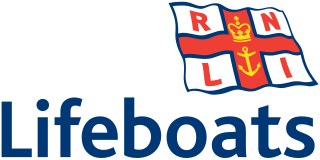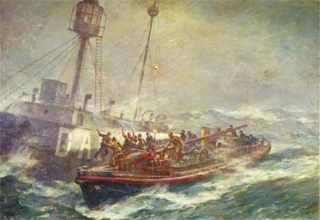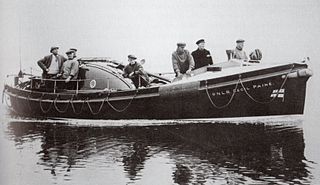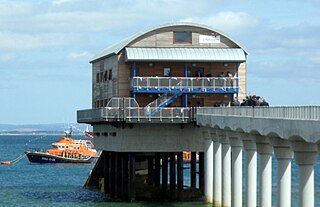Related Research Articles

The Royal National Lifeboat Institution (RNLI) is the largest of the lifeboat services operating around the coasts of the United Kingdom, Ireland, the Channel Islands, and the Isle of Man, as well as on some inland waterways.

Árainn Mhór is an island off the west coast of County Donegal in Ulster, the northern province in Ireland. Arranmore is the largest inhabited island of County Donegal, with a population of 478 in 2022, but has had a gradually falling native population since the 1990s. Its main settlement is Leabgarrow. The island is part of the Gaeltacht, with most of the inhabitants speaking Ulster Irish.

The SS English Trader was a British merchant ship wrecked off the coast of Norfolk, England in October 1941. After falling behind a convoy during the Second World War of which she was a part, the ship ran aground on the Hammond's Knoll sandbank and began to break up during a gale. Several rescue attempts by lifeboats failed, but a further attempt the following day by the Cromer Lifeboat rescued 44 of the crew, three having already been lost.

Great Yarmouth and Gorleston lifeboat station is a RNLI base in Norfolk, England. There were originally two separate stations at Great Yarmouth and Gorleston – two coastal towns either side of the River Yare. These were merged in 1926.

RNLB Mary Stanford was the Ballycotton Lifeboat from 1930 to 1959. Ballycotton is on Ireland's southern coast, a trade route to the Americas. There are many dangerous rocks and shallows with on-shore prevailing winds. Ballycotton has a long tradition of life-saving. Mary Stanford had 41 rescues, or "shouts", and saved 122 lives. She performed the notable Daunt Lightship rescue on 11 February 1936. After her withdrawal from service she lay for some years in a backwater of Dublin's Grand Canal Dock, but has now been returned to Ballycotton and restored.
SS Gallois was a French collier built in 1917 as Tynemouth and later Lord Aberconway. She was one of seven merchant vessels which became stranded and then wrecked on Haisbro Sands off the Norfolk coast on 6 August 1941 during the Second World War as part of Convoy FS 559.

William George Fleming GC (1865–1954) was a lifeboatman from Gorleston-on-Sea on the east coast of Norfolk, England. His service with the Royal National Lifeboat Institution (RNLI) spanned nearly fifty years, in which time he won the George Cross and the RNLI Medal in Gold and in Silver, and the Bronze Medal three times.

Torbay Lifeboat Station is the base for Royal National Lifeboat Institution (RNLI) search and rescue operations at Brixham, Devon in England. Brixham Lifeboat Station was opened in 1866 but since 1924 has been known as 'Torbay'. Since 2005 it has operated a Severn-class all-weather lifeboat (ALB) together with a D-class (IB1) inshore lifeboat (ILB).

HMS Sabre was an Admiralty S-class destroyer of the Royal Navy launched in September 1918 at the close of World War I. She was built in Scotland by Alex Stephens and completed by Fairfield Shipbuilding and Engineering Company in Govan. Commissioned for Fleet service in 1919, she was the first Royal Navy ship to carry this name.

RNLB Foresters Centenary is a retired Liverpool-class lifeboat of the Royal National Lifeboat Institution (RNLI), stationed in the English coastal town of Sheringham in the county of Norfolk in the United Kingdom. The lifeboat was on station for 25 years between 1936 and 1961 when she was sold. She has been restored to her original condition and is exhibited in Sheringham Museum.

RNLB Cecil Paine is a retired Liverpool-class non-self-righting lifeboat of the Royal National Lifeboat Institution. It was the second motor lifeboat to be stationed in the English coastal town of Wells-next-the-Sea in the county of Norfolk in the United Kingdom, and was on station at Wells from 25 July 1945 until she was sold in June 1965.

Walton and Frinton Lifeboat Station is a Royal National Lifeboat Institution (RNLI) station located in the town of Walton-on-the-Naze in the English county of Essex.

Bembridge Lifeboat Station is located in the village of Bembridge on the Isle of Wight in the United Kingdom. The station is located on the eastern approaches to The Solent, south of the area known as Spithead. The station is on one of the busiest shipping lanes in United Kingdom waters. The main boathouse stands away from the shore on a piled platform with slipway, and is linked to the shore by a pier gangway.

Shoreham Harbour Lifeboat Station is a Royal National Lifeboat Institution (RNLI) station located in the town of Shoreham-by-Sea in the English county of West Sussex.

Eastbourne Lifeboat Station is a Royal National Lifeboat Institution (RNLI) lifeboat station in the town of Eastbourne in East Sussex. Founded two years before the RNLI was established, the station has operated continuously since 1822, and its lifeboats have been responsible for saving over 700 lives.

Humber Lifeboat Station is an All-weather lifeboat station based at the mouth of the River Humber.

Scarborough Lifeboat Station is a Royal National Lifeboat Institution (RNLI) operated lifeboat station in Scarborough, North Yorkshire, England. A lifeboat was established at Scarborough in 1801, which makes it the third oldest lifeboat station in the United Kingdom.

Whitby Lifeboat Station is a Royal National Lifeboat Institution (RNLI) lifeboat station located in Whitby, North Yorkshire, England. It is one of nine situated along the Yorkshire coast.

Ballycotton Lifeboat Station is the base for Royal National Lifeboat Institution (RNLI) lifeboat at Ballycotton in County Cork, Ireland. It opened in 1858 and continues to operate today. Its most notable rescue was the crew of the Daunt Rock lightship in 1936 which kept the crew at sea for the best part of three days.
Arranmore Lifeboat Station is at Poolawaddy, a hamlet on the eastern coast of Arranmore Island, approximately 2 miles (3.2 km) north of Leabgarrow, the islands largest settlement. Arranmore, or Aran Island, is located in County Donegal, on the north west coast of Ireland.
References
- 1 2 3 4 "SS Stolwijk [+1940]". Wrecksite.eu. Retrieved 28 May 2022.
- 1 2 3 4 5 "Stolwijk – ID 6238". MarHisData (in English and Dutch). Emmen, Netherlands: Stichting Maritiem-Historische Databank. Archived from the original on 16 September 2020. Retrieved 16 September 2020.
- ↑ "1920 DS Kongsgaard (1)". Skipshistorie (in Norwegian). Norsk Skipsfartshistorisk Selskap. Archived from the original on 11 September 2019. Retrieved 16 September 2020.
- ↑ Gramstad, John M (March 1999). "Firma Brødrene Olsen A/S" (PDF). Skipet (in Norwegian). 1999 (1). Bergen: Norsk Skipsfartshistorisk Selskap.: 3–4. ISSN 0333-2683 . Retrieved 16 September 2020.
- ↑ "5605071" . Miramar Ship Index . Retrieved 15 September 2020.
- ↑ "Casualty reports". The Times. No. 43015. London. 26 April 1922. col F, p. 26.
- ↑ "Casualty reports". The Times. No. 43019. London. 1 May 1922. col D, p. 27.
- ↑ "Arnold Hague Ports database". Convoyweb.org.uk. Retrieved 27 May 2022.
- ↑ "Arnold Hague convoy database – SC convoys". Convoyweb.org.uk. Retrieved 27 May 2022.
- ↑ "Convoy battles – U-boat Operations". Uboat.net. Retrieved 27 May 2022.
- ↑ Sir Peter Gretton, Convoy Escort Commander (1964) had this to say about the involvement of the Sabre in the failed rescue attempt when he assumed command of the boat in early Jan 1941: Recently she had been badly damaged in a brave attempt to rescue the crew of a Dutch ship which had run ashore on Tory Island on the nor-Western coast of Ireland in a full gale. Sabre went in so close that she was almost among the breakers; and one great wave swept he decks, flattening the bridge and taking with it all the upper-deck fittings. The Captain had been badly injured and was still in hospital, but his was the worst case and fortunately no-one had been lost.
- ↑ Western Approaches War Diaries, 6–8 December 1940
- ↑ Nationaal Archief 2.16.31 Archief van de Buitengewone Raad voor de Scheepvaart te Londen 1940 – 1946, inv.nr. 23: dossier inzake de stranding van het s.s. Stolwijk
- ↑ Nederlands Instituut voor Militaire Historie (NIMH), Commissie Onderscheidingen Koopvaardij (080), inv.nr. 2, Stolwijk
- ↑ Elder, Michael (1963), For Those in Peril: The Story of the Life-boat Service, publisher J. Murray
- ↑ "Voormalige Graflocatie Nederlandse Oorlogsslachtoffers". Traces of War (in Dutch). Retrieved 22 June 2020.
- ↑ "I'll Go – Single by Jerry Early". 7 December 2015. Retrieved 27 May 2022– via Apple Music.
- ↑ "The Ballad of the Stolwijk Rescue – Lyric Feature". Rte.ie. 7 September 2020. Retrieved 27 May 2022.
- ↑ "Lifeboat crew honoured for rescue of Dutch men in 1940". RTÉ.ie . 6 August 2017.